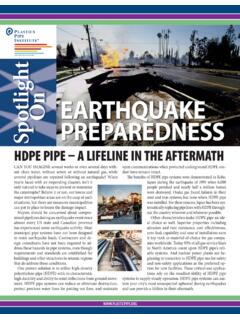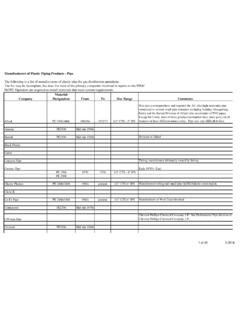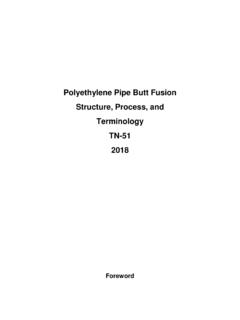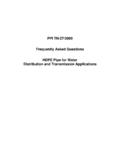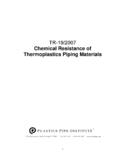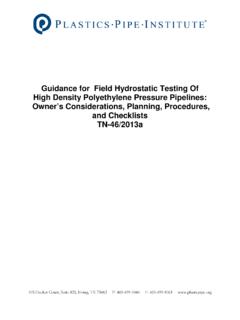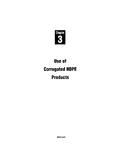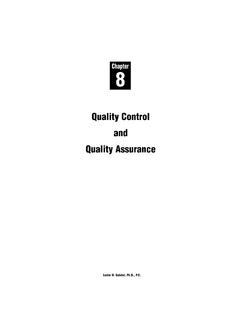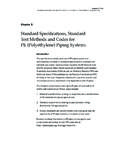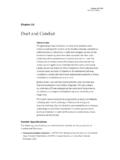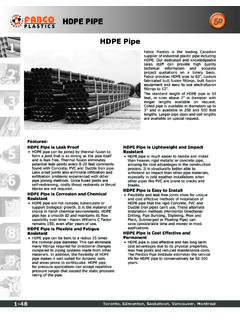Transcription of Chapter 5: Design Methodology - Plastics Pipe Institute
1 5 ChapterDesignMethodologyCHAPTER 5: Design METHODOLOGYO verview of Structural ConsiderationsAll pipe , whether flexible or rigid, relies on the backfill structure to transfer loads into the bedding. As a result, all pipe also must be installed as designed to perform as Chapter sets forth the Design Methodology for corrugated polyethylene pipemeeting the American Association of State Highway and Transportation Officials(AASHTO) M252 and M294 and MP7 used in non-pressure applications. Sectionproperties for use in the Design procedure are presented. Material properties, backfillcriteria and load conditions play important roles in pipe performance.
2 The designprocedure evaluates deflection, buckling, bending stress, bending strain and wallstress. This procedure establishes limits for each condition. Height of Cover tables showing minimum cover in trafficked installations andmaximum cover heights under a variety of backfill conditions are shown in Tables5-4 and 5-5 respectively. Sample calculations also are provided. Corrugated polyethylene pipe performance has been extensively documented andresearched through laboratory and field installations. This work reinforces the conservatism of this Design Chapter was developed to assist those who utilize or specify corrugated polyethylene pipe , meeting the American Association of State Highway andTransportation Officials (AASHTO) M252 and M294 specifications, as well asCAN/CSA standards, in non-pressure applications to better understand its structuralcapabilities.
3 Although it has been in use for nearly three decades in the United Statesand Canada, corrugated polyethylene pipe is still considered to be one of the newerproducts in the storm sewer and culvert markets. An extensive amount of laboratorytesting, computer simulations and actual installations confirm the performance ofthese products. pipe behavior can be broadly classified as flexible or rigid, depending on how it performs when installed. Flexible pipe can move, or deflect, under loads withoutstructural damage. Corrugated polyethylene pipe is an example. Rigid pipe is sometimes classified as pipe that cannot deflect significantly without structural distress, such as cracking.
4 Reinforced and non-reinforced concrete pipe are METHODOLOGYCHAPTER 5: Design METHODOLOGYBoth flexible and rigid pipe depend on proper backfill. Backfill characteristics, andalso trench configuration in the case of rigid pipe , enter into the Design flexible pipe , deflection allows loads to be transferred to and carried by the back-fill. Rigid pipe transmits most of the load through the pipe wall into the backfill is very important in determining how the load is transferred, foreither flexible or rigid pipe . Refer to the appropriate chapters of this Design manualfor further information on proper installation research projects have investigated the behavior of flexible pipe performance has been evaluated through the use of actual fieldinstallations, post-installation inspections, load cell tests and finite element computeranalyses.
5 As a result, nearly three decades after its introduction, the behavior of corrugated polyethylene pipe has probably been analyzed more than any other conventional drainage pipe . The information in subsequent areas of this document provides a step-by-step guidefor the structural Design of gravity flow corrugated polyethylene pipe . The methodologyrepresents the state-of-the-art Design procedure, and has been proven through actualinstallations to be Between Flexible and Rigid PipeNearly all pipe can be classified as either flexible or rigid, depending on how it performs when installed. Flexible pipe takes advantage of its ability to move, ordeflect, under loads without structural damage.
6 Common types of flexible pipe aremanufactured from polyethylene, polyvinyl chloride (PVC), steel and pipe is sometimes classified as pipe that cannot deflect more than 2% withoutsignificant structural distress, such as cracking. Reinforced and non-reinforced concrete pipe and clay pipe are examples. Figure 5-1 shows the difference between how flexible and rigid pipe respond to 5-1: pipe Response to LoadingFigure 5-1 Chapter 5: Design METHODOLOGYBoth flexible and rigid pipe require proper backfill, although the pipe /backfill interaction differs. When flexible pipe deflects against the backfill, the load is transferred to and carried by the backfill.
7 When loads are applied to rigid pipe , on the other hand, the load is transferred through the pipe wall into the bedding. For both types of materials, proper backfill is very important in allowing this load transfer to occur. Figure 5-2 shows the pipe /backfill interaction and the corresponding load pipe offers significant structural benefits to the project designer. In many situations, a properly installed flexible pipe can be buried much deeper than a similarly installed rigid pipe because of the flexible pipe /backfill interaction. A rigidpipe is often stronger than the backfill material surrounding it, thus it must supportearth loads well in excess of the prism load above the pipe .
8 Conversely, a flexible pipe is not as strong as the surrounding backfill; this mobilizes the backfill envelopeto carry the earth load. The flexible pipe /backfill interaction is so effective at maximizing the structural characteristics of the pipe that it allows the pipe to beinstalled in very deep installations, many times exceeding allowable cover for rigidpipe when identically Viscoelastic Nature of Corrugated Polyethylene PipeFlexible pipe is manufactured from either Plastics or metals. Plastics and metals are, however, very different types of materials. Metals exhibit elastic properties and Plastics exhibit viscoelastic, or time-dependent, characteristics.
9 It is thisdifferencethat is key to understanding corrugated polyethylene pipe and its installed perform-ance as compared to other types of flexible 5-2 Figure 5-2: pipe /Backfill InteractionCHAPTER 5: Design METHODOLOGYM aking the assumption that the characteristics of viscoelastic materials can be analyzed using the same techniques used for elastic materials will undoubtedly yieldmisleading results. One of the most common misconceptions surrounding Plastics ,particularly polyethylene, is that they lose strength with time. This idea stems fromapplying elastic behavior criteria to a viscoelastic material. When a corrugated poly-ethylene pipe is deflected, or strained, in the laboratory, the stress versus strain curvethat results has a high initial modulus that almost immediately begins to 5-3 shows a diagram of what the stress/strain relationship could look elastic modulus, or flex modulus as it is commonly referred to for viscoelasticmaterials, is the ratio between the change in strain and the change in stress modulus is high initially, but then begins to decrease.
10 The pipe appears torequire less force over time to maintain the same strain level. If the material behavedaccording to elastic principles, it could be described as losing strength. However,polyethylene is viscoelastic and the conclusion that the material is losing strengthwould be erroneous. This concept is not an insignificant one for polyethylene. With typically referencedshort-term (quick) and long-term modulus values of 110,000 psi (758 MPa) and22,000 psi (152 MPa), respectively, Design results would be very different. The question of which value to use in Design certainly deserved more attention, andresearch projects were initiated to gain more understanding.
